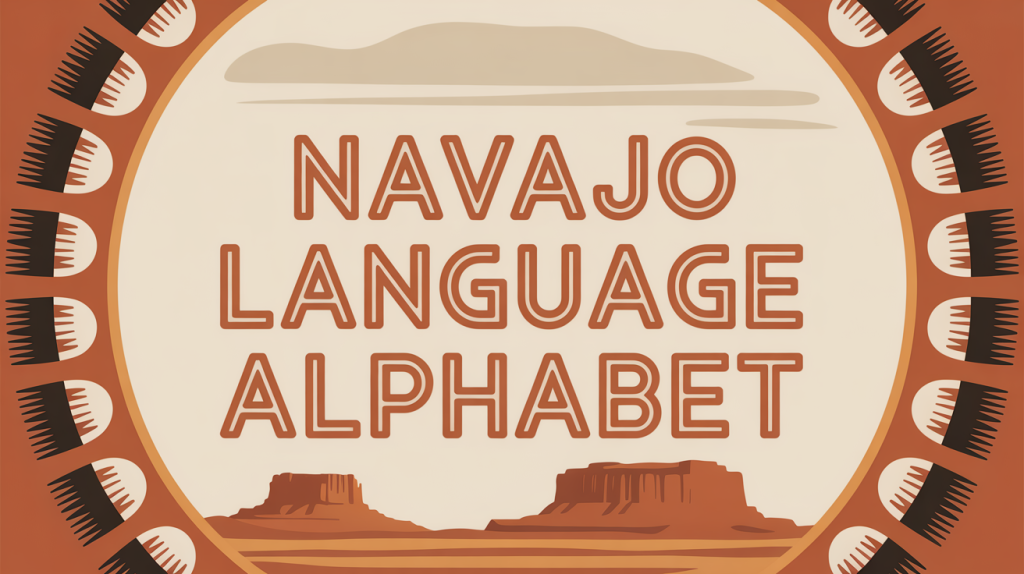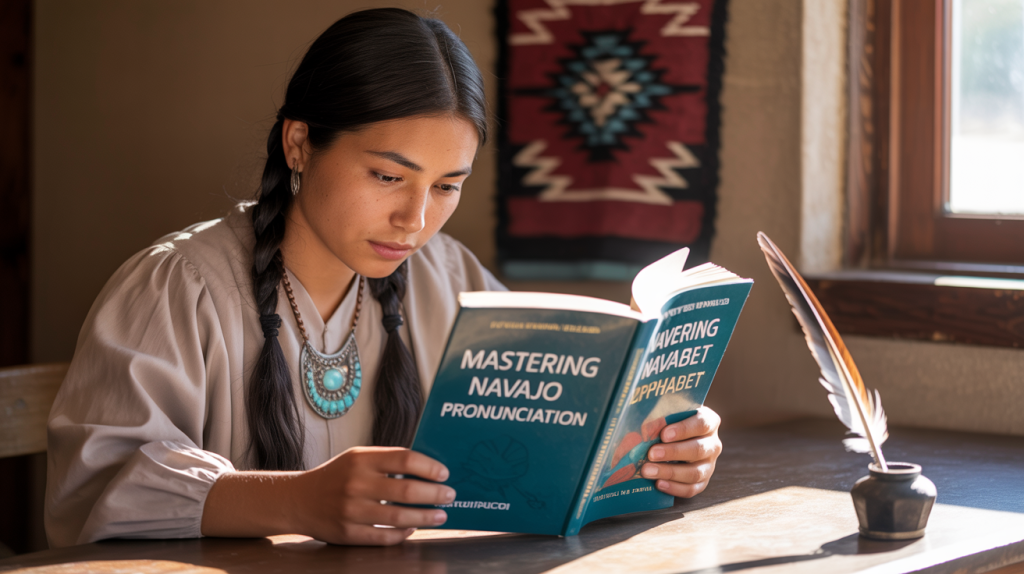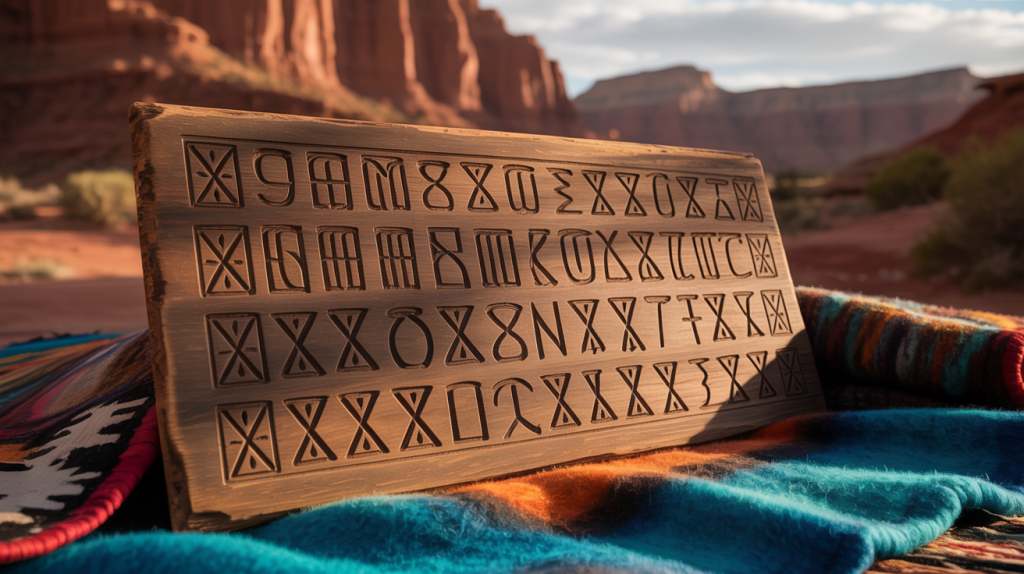Master the fascinating Navajo alphabet with this comprehensive guide covering pronunciation, special characters, and essential learning tips for beginners and educators.
The Navajo language, known in its native form as Diné Bizaad, stands as one of the most widely spoken Native American languages in North America, with over 170,000 speakers primarily across Arizona, New Mexico, Utah, and Colorado.
What makes this ancient language particularly fascinating is its unique writing system—the Navajo alphabet—which captures the complex tonal and phonetic nuances that have been passed down through generations of the Diné people.
Unlike many world languages, Navajo was traditionally an oral language with no written form until the 20th century.
Today, the standardized Navajo alphabet serves as a crucial bridge between preserving cultural heritage and enabling modern education, making it an invaluable tool for language learners, educators, and cultural preservationists.
This comprehensive guide will take you through everything you need to know about the Navajo language alphabet, from its historical development to practical pronunciation tips and learning resources.
History and Development of the Navajo Writing System

The Oral Tradition Era
For centuries, the Navajo language existed purely in oral form, with knowledge, stories, and cultural wisdom transmitted through spoken word from generation to generation.
The rich complexity of Diné Bizaad, with its intricate tonal system and unique phonetic characteristics, was perfectly preserved through this oral tradition.
Early Writing Attempts (1850s-1920s)
The first attempts to create a written form of Navajo began in the mid-19th century, primarily through the efforts of:
- Missionaries who sought to translate religious texts
- Government agents working in Navajo communities
- Early linguists studying Native American languages
These early systems were inconsistent and often failed to capture the language’s tonal complexity and unique sounds.
The Standardization Breakthrough (1930s-1940s)
The modern Navajo alphabet was developed between 1939 and 1943 by a dedicated team of linguists and educators:
- Robert Young – Linguist and educator
- William Morgan – Navajo linguist and translator
- John Peabody Harrington – Ethnolinguist
- Oliver La Farge – Anthropologist and writer
This collaborative effort created the first standardized writing system that could accurately represent the full range of Navajo sounds, including:
- Tonal variations
- Nasalized vowels
- Ejective consonants
- Unique consonant clusters
The standardized alphabet revolutionized Navajo education and literacy, enabling the creation of textbooks, dictionaries, and educational materials that preserved and transmitted the language in written form.
The Complete Navajo Alphabet Chart
The Navajo writing system uses a modified Latin script with 33 basic letters plus additional symbols for tones and nasalization. Here’s the comprehensive alphabet chart:
Vowels and Vowel Modifications
| Symbol | Sound Description | Example Pronunciation | Notes |
|---|---|---|---|
| a | “a” as in “father” | /a/ | Basic vowel |
| ą | Nasalized “a” | /ã/ | Nasal quality |
| á | High-tone “a” | /á/ | Rising pitch |
| e | “e” as in “bed” | /e/ | Basic vowel |
| ę | Nasalized “e” | /ẽ/ | Nasal quality |
| é | High-tone “e” | /é/ | Rising pitch |
| i | “i” as in “machine” | /i/ | Basic vowel |
| į | Nasalized “i” | /ĩ/ | Nasal quality |
| í | High-tone “i” | /í/ | Rising pitch |
| o | “o” as in “note” | /o/ | Basic vowel |
| ǫ | Nasalized “o” | /õ/ | Nasal quality |
| ó | High-tone “o” | /ó/ | Rising pitch |
Consonants
| Symbol | Sound Description | English Equivalent | Notes |
|---|---|---|---|
| b | Voiced bilabial stop | “b” in “bat” | Standard consonant |
| ch | Voiceless affricate | “ch” in “church” | Two-letter combination |
| ch’ | Ejective affricate | Ejective “ch” | Glottalized sound |
| d | Voiced alveolar stop | “d” in “dog” | Standard consonant |
| dl | Lateral affricate | Unique sound | No English equivalent |
| dz | Voiced affricate | “ds” in “adze” | Two-letter combination |
| g | Voiced velar stop | “g” in “go” | Standard consonant |
| gh | Voiced velar fricative | Voiced “ch” | No exact English equivalent |
| h | Voiceless glottal fricative | “h” in “hat” | Standard consonant |
| hw | Labialized h | “wh” in some dialects | Voiceless w sound |
| j | Voiced palatal affricate | “j” in “Jacques” | French-like pronunciation |
| k | Voiceless velar stop | “k” in “kite” | Standard consonant |
| k’ | Ejective velar stop | Ejective “k” | Glottalized sound |
| kw | Labialized k | “qu” in “quick” | Two-letter combination |
| l | Voiced lateral approximant | “l” in “loop” | Standard consonant |
| ł | Voiceless lateral fricative | Unique sound | Welsh “ll” similar |
| m | Voiced bilabial nasal | “m” in “map” | Standard consonant |
| n | Voiced alveolar nasal | “n” in “net” | Standard consonant |
| s | Voiceless alveolar fricative | “s” in “sun” | Standard consonant |
| sh | Voiceless palatal fricative | “sh” in “shoe” | Two-letter combination |
| t | Voiceless alveolar stop | “t” in “top” | Standard consonant |
| t’ | Ejective alveolar stop | Ejective “t” | Glottalized sound |
| tł | Voiceless lateral affricate | Unique cluster | No English equivalent |
| tł’ | Ejective lateral affricate | Ejective tł | Glottalized cluster |
| ts | Voiceless alveolar affricate | “ts” in “cats” | Two-letter combination |
| ts’ | Ejective affricate | Ejective “ts” | Glottalized sound |
| w | Voiced labial-velar approximant | “w” in “win” | Standard consonant |
| x | Voiceless velar fricative | “ch” in “Bach” | German-like sound |
| y | Voiced palatal approximant | “y” in “yes” | Standard consonant |
| z | Voiced alveolar fricative | “z” in “zoo” | Standard consonant |
| zh | Voiced palatal fricative | “s” in “measure” | Two-letter combination |
| ‘ | Glottal stop | Stop between vowels | Vocal break |
Special Combinations and Long Vowels
Long Vowels: Created by doubling the vowel letter
- aa – Long “a” sound
- ee – Long “e” sound
- ii – Long “i” sound
- oo – Long “o” sound
Tone Combinations:
- Rising tone: unmarked to high tone (a + á)
- Falling tone: high tone to unmarked (á + a)
Unique Features of the Navajo Alphabet

Missing English Letters
The Navajo alphabet symbols notably exclude several letters common in English:
- No Q, R, U, V, F, or P in the standard alphabet
- This reflects the phonetic reality of the Navajo language
Distinctive Characteristics
1. Ejective Consonants
Ejective sounds (marked with apostrophes) are produced with a sharp release of air:
- ch’ – ejective affricate
- k’ – ejective stop
- t’ – ejective stop
- ts’ – ejective affricate
- tł’ – ejective lateral affricate
2. The Unique ł Sound
The ł represents a voiceless lateral fricative, similar to the Welsh “ll” but unique among world writing systems. This sound is produced by placing the tongue against the roof of the mouth and forcing air around the sides.
3. Nasalized Vowels
Navajo nasalized vowels are marked with an ogonek (˛) beneath the vowel:
- ą, ę, į, ǫ – These create distinct meanings and are essential for proper pronunciation
4. Tonal System
High tones are marked with acute accents (á, é, í, ó), while low tones remain unmarked. The tonal system creates:
- Lexical distinctions – Different tones create different word meanings
- Grammatical functions – Tones can indicate verb aspects and other grammatical features
Mastering Navajo Alphabet Pronunciation

Essential Pronunciation Guidelines
Vowel Sounds
- Pure vowel sounds – Navajo vowels are “pure” without the gliding found in English
- Length matters – Long vowels (aa, ee, ii, oo) are held significantly longer
- Nasalization – Practice directing airflow through the nose for ą, ę, į, ǫ
Consonant Challenges
- Ejectives – Practice the sharp, glottalized release of air
- ł sound – Start by practicing the “sh” sound, then move your tongue to create lateral airflow
- Consonant clusters – Practice dl, tł, and other unique combinations slowly
Practice Techniques
- Listen to Native Speakers
- Navajo Nation radio programs
- Online audio dictionaries
- YouTube pronunciation videos
- Record Yourself
- Compare your pronunciation to native speakers
- Focus on problem sounds
- Practice regularly with consistent feedback
- Start with Basic Words
- Learn simple vocabulary first
- Master individual sounds before complex words
- Build confidence with achievable goals
Learning the Navajo Script: Tips and Resources

For Complete Beginners
Step 1: Master the Basic Sounds
- Start with the five basic vowels (a, e, i, o)
- Learn simple consonants (b, d, g, h, j, k, l, m, n, s, t, w, y, z)
- Practice daily pronunciation drills
Step 2: Introduce Special Characters
- Add nasalized vowels (ą, ę, į, ǫ)
- Learn ejective consonants (ch’, k’, t’, ts’, tł’)
- Practice the unique ł sound
Step 3: Understand Tones and Length
- Learn high-tone markers (á, é, í, ó)
- Practice long vowels (aa, ee, ii, oo)
- Study how tones change word meanings
Digital Tools and Technology
Keyboard Setup
- Install Navajo keyboard layouts for computers and mobile devices
- Learn shortcut keys for special characters
- Practice typing simple words and phrases
Recommended Software
- Keyman keyboards – Free Navajo keyboard installations
- Unicode fonts – Ensure proper display of special characters
- Language learning apps – Several apps now include Navajo alphabet training
Educational Resources
Online Learning Platforms
- Navajo Language Academy – Comprehensive courses
- Rosetta Stone Navajo – Interactive learning modules
- Duolingo – Basic Navajo lessons (in development)
Print Materials
- Navajo-English dictionaries with phonetic guides
- Children’s books in Navajo for basic reading practice
- Grammar textbooks for advanced learners
Cultural Significance and Modern Applications

Preserving Cultural Heritage
The Navajo writing system serves as more than just a communication tool—it’s a vital instrument for cultural preservation:
- Traditional stories can now be recorded in written form
- Ceremonial knowledge (where appropriate) can be documented
- Historical accounts from Navajo perspectives are preserved
Educational Impact
In Schools
- Immersion programs use the alphabet for complete Navajo education
- Bilingual education helps students maintain cultural identity
- literacy programs for adult learners reconnecting with their heritage
Community Programs
- Elder knowledge transfer projects document traditional wisdom
- Youth engagement initiatives use modern technology with traditional language
- Community newspapers and publications in Navajo
Modern Technology Integration
- Social media posts in Navajo using proper alphabet characters
- Website development with Navajo language content
- Mobile apps for language learning and cultural education
- Digital storytelling projects preserving oral traditions
Frequently Asked Questions
How many letters are in the Navajo alphabet?
The Navajo alphabet contains 33 basic symbols, with additional diacritical marks for tones and nasalization, making it one of the more complex Native American writing systems.
Is the Navajo alphabet hard to learn?
While the alphabet presents unique challenges (ejective consonants, tonal marks, nasalized vowels), systematic study and regular practice make it achievable for dedicated learners. The key is starting with basic sounds and gradually adding complexity.
Can I type Navajo on my computer?
Yes! Modern computers and mobile devices support Navajo characters through:
- Unicode font support
- Specialized keyboard layouts
- Input method editors (IMEs)
- Online typing tools
Where can I practice reading Navajo?
Start with:
- Children’s books in Navajo
- Simple news articles from Navajo publications
- Educational websites with beginner texts
- Community bulletin boards and signage in Navajo-speaking areas
Are there different dialects that affect the alphabet?
While regional pronunciation variations exist, the standardized Navajo writing system remains consistent across dialects. The alphabet accurately represents the sounds found in all major Navajo-speaking regions.
Conclusion: Embracing the Beauty of Diné Bizaad
The Navajo language alphabet represents far more than a collection of letters and symbols—it embodies the resilience, wisdom, and cultural richness of the Diné people.
Through its unique features, including ejective consonants, nasalized vowels, and tonal markers, this writing system captures the full beauty and complexity of one of North America’s most important indigenous languages.
Whether you’re a student beginning your journey with Navajo alphabet pronunciation, an educator developing curriculum materials, or a community member working to preserve and revitalize Diné Bizaad, mastering this alphabet opens doors to centuries of cultural knowledge and contemporary community connection.
Learning the Navajo script requires patience, practice, and respect for the cultural context in which it is situated.
But the rewards—access to traditional stories, the ability to communicate with elders, and participation in cultural preservation efforts—make every moment of study worthwhile.
As you continue your exploration of the Navajo language, remember that each character you learn, each sound you master, and each word you read contributes to the ongoing vitality of Diné Bizaad. The alphabet serves as your gateway to one of the world’s most fascinating and culturally significant languages.
Ready to start your Navajo language journey? Begin with the basic vowels and consonants, practice daily pronunciation, and connect with native speakers in your community or online. The beautiful complexity of the Navajo language alphabet awaits your discovery.
Source: Wikipedia – Navajo Language: Orthography
Related Post: NAVAJO






